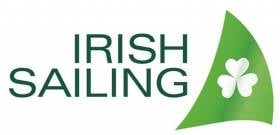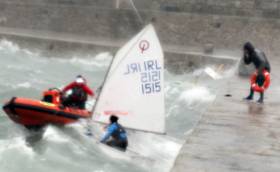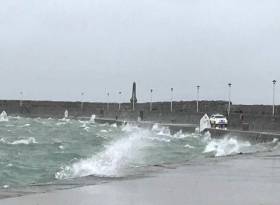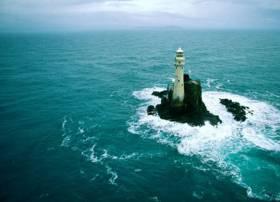Displaying items by tag: Storm Brian
Irish Sailing Optimist Squad Investigation is Launched
An 'independent external' investigation into Saturday's Irish Sailing Optimist performance squad incident during Storm Brian at Dun Laoghaire is underway.
According to a statement on the association website last night, Irish Sailing President Jack Roy and CEO Harry Hermon have appointed Philip Scallan as independent external lead investigator. Scallan has already mapped out the areas of investigation to the President and requested additional time to investigate and consult with all parties.
It is understood a board meeting of the national governing body was held last night.
Roy commented: “Our priority is always the safety of our sailors and we are determined to establish all the facts relating to this incident. We look forward to receiving Mr Scallan’s report and implementing his recommendations so that we learn as much as we can from what happened and maintain the confidence of sailors and their families in our programmes”.
The statement says Scallan is a Safety Officer with many years of experience assessing and implementing safety standards in Irish and international sailing events. He will be assisted in this external investigation by Ger Keeling, a marine engineer and former CEO of the International Marine Rescue Federation who works with both Irish Water Safety and the RNLI.
According to the association, Scallan, who is based in the UK, will be travelling to Dun Laoghaire over the weekend and requests that any parent, sailor, witness, coach or any other party who feels that their contribution is relevant to the investigation, to get in contact with him promptly at [email protected].
Following a review of all the information received, and consultations with all the parties involved, Scallan and Keeling will also review Irish Sailing’s health and safety protocols before presenting their report which is expected to be finalised by mid-November and published.
Dun Laoghaire Optimist Training Incident – The Young People Must Be Our First Priority
W M Nixon on the aftermath of Saturday's Optimist dinghy training incident during Storm Brian.
“A boat, by God, it’s just a gleamin’ beautiful creation. And when you pull the sail up on a boat, you’ve got a little bit of somethin’ God-given. Man, it goes bleetin’ off like a bird wing, you know, and there’s nothin’ else like it.”
The speaker was Clark Mills of Clearwater, Florida, who very rightly was recently inducted posthumously into American Sailing’s Hall of Fame. In 1947, Clark Mills developed the design of the Optimist dinghy for the kids of his community in response to a request from two public-spirited citizens, who reckoned that a hyper-economical little sailing boat would encourage children to interact positively with the warm and wonderful sailing waters of their sun-blessed neighbourhood.
Clark Mills was an ingenious back-street boatbuilder whose seemingly unassuming design was so clever that three Optimists could be built out of four sheets of standard 8ft x 4ft marine plywood. But it remained a localized way of making sailing accessible until a Scandinavian sail training ship was in port, and the captain was very impressed with these little sailing prams.
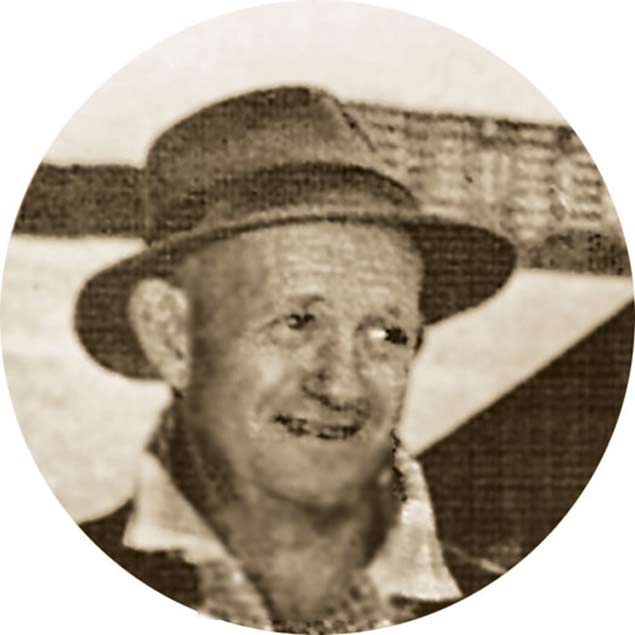 Clark Mills (1915-2001) designer and first builder of the Optimist Dinghy in 1947, has recently been posthumously inducted into American Sailing’s Hall of Fame
Clark Mills (1915-2001) designer and first builder of the Optimist Dinghy in 1947, has recently been posthumously inducted into American Sailing’s Hall of Fame
So he took one of them on board his tall ship, and brought her home to Sweden, and that was the end of the Age of Innocence for the Optimist dinghy. Once the Scandinavians had decided that these wonderful little boxes were the future of sailing for their young children despite their own tradition of very elegant sailing craft, the Optimist dinghy went global, and now more than 300,000 have been built.
It’s far indeed from the balmy sandy islands of Clearwater to the old granite pond of Dun Laoghaire on a late October Saturday, when the cream of Irish Optimist sailing – sixteen young helms from all over Ireland and their rather expensive boats - have been assembled on a long-planned, intensive and costly training session with a coach who is renowned for his ability to empathise with the junior sailors, and greatly improve their performance.
The pressure is on for busy instructive sailing, but the pressure meteorologically speaking is through the floor, as the centre of Storm Brian approaches Dublin Bay in textbook style. It’s so pure textbook that a patch of blue sky actually appears. But there’s a nice breeze, and the kids are sent out sailing because, after all, they’re in a harbour which is a giant pond, and if the weather does deteriorate, the pond provides shelter and security.
But within 25 minutes, the weather goes beyond deterioration. It falls off a cliff. Classic style again, the centre of the low has moved to the northeast: “Sharp rise after low, foretells a stronger blow”. The sudden west to northwest wind was over 40 knots, with a highest recorded gust in Dun Laoghaire of 51 knots, and that with dense air to increase the pressure even further.
Close in against the East Pier, the harbour becomes a boiling cauldron of backwash with completely unsailable conditions, and the four Optimists near it are jammed against the wall. But as it’s high water it’s possible to haul their young skippers ashore. The rest of the fleet managed to return to base, and all are well scared, but are soon recovering as kids do.
Or at least that’s how they show it, for these after all are the elite squad, and there’s peer pressure. Either way, it has to be clearly asserted that the outcome of all the continuing deliberations on this incident should place the effect it has had and is having on the kids first, middle, and last.
They’re a remarkably mature bunch of young people for their age, but the organisation of society is such that all responsibility in a situation like this ultimately falls on adults, and we as a sailing community will be judged on how this is worked out in the days, weeks and months ahead.
Inevitably, officialdom will have to move at its own ponderous pace, but meanwhile the kids, the parents and the Optimist sailing world in Ireland are moving at their own different paces to take the experience in board, while getting on with life at the same time.
Talking to a parent who had two kids rescued from the East Pier, he says their resilience is a wonder to behold. One is already sailing again in a team racing series, and the other is keenly anticipating another Optimist training session this weekend. As for sailing’s real community, the local rather than the official, they have been quietly doing good work by stealth – the only true good work – by lending replacement boats for those whose craft have been damaged or wrecked, in order that the programme can continue with just this one interruption.
On the business side, the parent to whom we talked felt much more sanguine about a satisfactory insurance settlement than he had at the beginning of the week. And even though all the parents are still in something of a state of shock, the needs and expectations of the keen kids are encouraging them to move on and be positive.
For outsiders, all this may sound almost too good to be true. But anyone who has been even on the edge of the Optimist world will know that it’s one very extraordinary place. It’s not for everyone by any means. But for those for whom it clicks, it’s a miraculous and marvellous experience.
So as we see the wheels of officialdom begin to turn, with positions being taken up as various organisations seek to protect their image and their good standing, is it too much to ask that the top people remember to take on board the opinions of the kids involved every bit as much as they take into consideration the storm of criticism which has spread across social media?
Teaching and coaching are very special talents. But just because you’re very good at helping young people to sail even faster, that doesn’t necessarily mean that you can make sage judgments about future weather and the organisation of events. In fact, shared enthusiasm across the generations about improved performance can be a potent force for clouding judgment. That seems to have happened here. We’re not trying to make excuses. We’re just trying to explain how something happened.
So as people sound off about the need “to make heads roll”, how about quietly asking the 16 kids involved what they think?
That surely is what Clark Mills would have done.
Optimist Team Had 'Weather Window Providing Reasonable Conditions for Such Activity' – Irish Sailing Statement
Irish Sailing, the national governing body for the sport in Ireland, has issued a statement following the rescue of its 16-boat National Optimist Squad during Storm Brian on Saturday lunchtime in Dun Laoghaire Harbour. In the statement, released yesterday, the association says 'all usual risk assessments were undertaken before launching and the forecast was for a weather window providing reasonable conditions for such activity'.
Irish Sailing also says it is 'now investigating what protocols and assessments may need to be reviewed and/or revised so that we maintain all safety standards'. Read the full statement below.
The rescue, reported by Afloat.ie here, involved local yacht club RIBs, Dun Laoghaire Coast Guard and RNLI inshore boats. The incident was widely reported in the weekend media and attracted significant social media comment. Joe Mag Raollaigh of RTE News captured video of one of the Oppy dinghies being wrecked against the harbour wall as north-westerly winds reached over 40–knots.
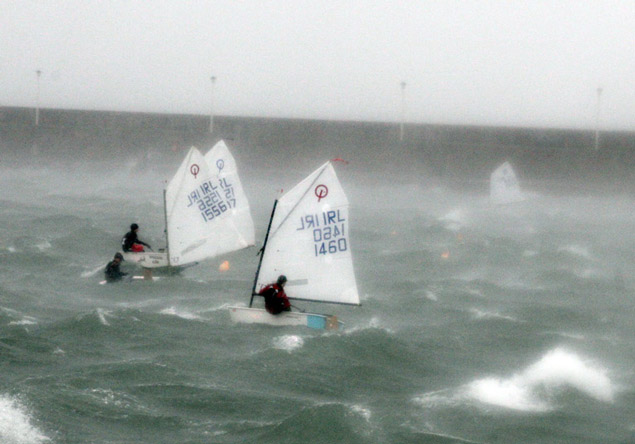 Big breeze for training in Dun Laoghaire Harbour. Photo: Stephen Collins of Collins Picture Agency
Big breeze for training in Dun Laoghaire Harbour. Photo: Stephen Collins of Collins Picture Agency
Dangerous situation in @dunlaoghaire harbour averted after sailors rescued from small boats overcome by wind & waves #stormbrian #rtenews pic.twitter.com/sKN0rTT2HL
— Joe Mag Raollaigh (@joemagraollaigh) October 21, 2017
Stephen Collins of Collins Picture Agency captured some dramatic pictures of the training session and the rescue and these appeared on Dublin Live here and the Irish Times. The Irish Independent ran a story here.
The ISA Statement reads:
UPDATE ON OPTIMISTS IN DUN LAOGHAIRE YESTERDAY
'Sixteen Optimists were launched yesterday morning (Saturday 21 October) inside Dun Laoghaire Harbour as part of a routine high-performance training programme, along with the safety boats which are present at all training events. All usual risk assessments were undertaken before launching and the forecast was for a weather window providing reasonable conditions for such activity. A squall came in and the decision was made to send the sailors to shore immediately. The Dun Laoghaire Coast Guard and RNLI inshore boats were launched as a precaution but at that stage all the sailors were onshore. No sailor was harmed.
In circumstances like this, there are tried and tested protocols that come into effect with all bodies working together for a safe outcome. The safety of the sailors was prioritised over equipment. We are now investigating what protocols and assessments may need to be reviewed and/or revised so that we maintain all safety standards'
Following the rescue a number of the children's dinghies were left abandoned overnight in the harbour then picked up the following morning.
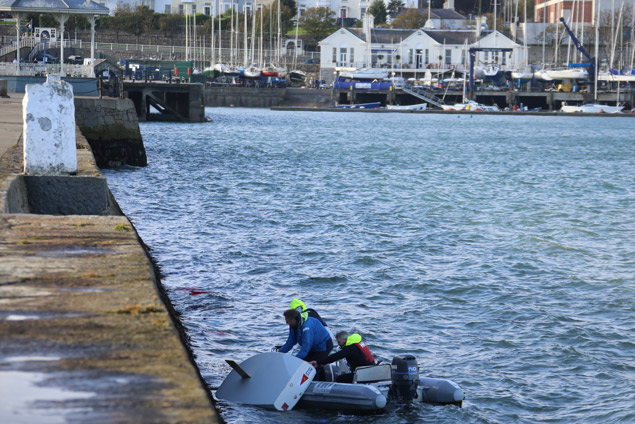 A Royal Cork Optimist dinghy is recovered into a RIB off the East Pier at Dun Laoghaire on Sunday
A Royal Cork Optimist dinghy is recovered into a RIB off the East Pier at Dun Laoghaire on Sunday
Storm Brian Hits Dun Laoghaire: Optimist Dinghies & Sailing Cruiser End Up On Harbour Walls
Storm Brian's strong north–westerly winds, gusting over 40–knots, left both a training group of Optimist sailors and at least one moored cruiser on Dun Laoghaire harbour wall this lunch time.
Eyewitness reports say that four Optimist dinghies were 'abandoned' in the squall at the East Pier. The eyewitnesses say the junior sailors involved are safe and accounted for.
Dangerous situation in @dunlaoghaire harbour averted after sailors rescued from small boats overcome by wind & waves #stormbrian #rtenews pic.twitter.com/sKN0rTT2HL
— Joe Mag Raollaigh (@joemagraollaigh) October 21, 2017
In a separate incident, in what appears to be case of broken ground tackle, a sailing cruiser ended up on the West Pier earlier this morning.
 A launch attends to a sailing cruiser lying up against the West Pier wall at Dun Laoghaire
A launch attends to a sailing cruiser lying up against the West Pier wall at Dun Laoghaire
Water Temp:13.8 °C, Avg Wind:29kts, Gust:42kts, Wind Dir:290 °(W), Gust Dir:302 °(NW), Wave Height:0.9m at 21/10/2017 14:29:00
— Dublin Bay Buoy (@DublinBayBuoy) October 21, 2017
The incidents have prompted a statement regarding today's on the water activities from the Irish National Sailing & Powerboat School Chief Instructor & Director, Kenneth Rumball:
'The Irish National Sailing & Powerboat School cancelled most of it on the water activities due to the adverse weather forecast for Saturday the 21st October 2017.
We had a small number of our brightly colored craft on the water for a very short period of time on Saturday morning.
A small number of powerboat clients were operating in a very well sheltered area of the inner harbour for a time also this morning.
Knowing the weather was due to hit later that morning, all clients, staff and personnel were off the water once the worst of the westerly winds started to hit.
None of the craft in the videos and pictures circulating the internet from Dun Laoghaire Harbour are craft belonging to the Irish National Sailing & Powerboat School'.
The centre of #StormBrian is now over Dublin pic.twitter.com/hj3L6SMgwU
— Met Éireann (@MetEireann) October 21, 2017
Update here.
Storm Brian: A Big Thank you to Mullingar Sailing Club & the GP14s Before More Meteorological Mayhem Arrives
Before the imminent Storm Brian starts disrupting plans tonight and over the weekend, let’s take a final look back at the recent events in wind-battered old Ireland writes W M Nixon. We have been so busy marvelling at recorded wave heights, something which is relatively new with any precision around our coast, that the sheer speed of the wind has been almost overlooked.
Yet it bears re-examination, if only in honour of the memory of Ireland’s Francis Beaufort, who grappled with the challenge of a meaningful analysis of wind sped and effects. Thus you might think that Beaufort’s Force 6 (22 to 27 knots) would be about five times as powerful as Beaufort Force 2 (4-6 knots). But Beaufort didn’t measure it as a “Force” without a reason. He was more interested in effect than in actual wind speed, with a Force 6 exerting very much more than three times the pressure of a Force 2.
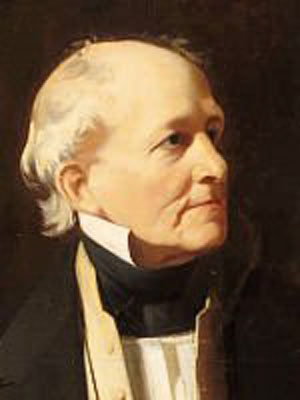 Wind measurement pioneer Admiral Francis Beaufort (1774-1857) was born in Navan. It was a remarkably accurate and user-friendly system in an era before wind speed measuring equipment became precise, but these days we’ve reverted to km/h instead of knots, and specific speeds instead of forces. Either way, the top wind speeds recorded in Storm Ophelia on Monday are an eloquent testimony to the clearcut progress of a slowly-decaying storm across Ireland:
Wind measurement pioneer Admiral Francis Beaufort (1774-1857) was born in Navan. It was a remarkably accurate and user-friendly system in an era before wind speed measuring equipment became precise, but these days we’ve reverted to km/h instead of knots, and specific speeds instead of forces. Either way, the top wind speeds recorded in Storm Ophelia on Monday are an eloquent testimony to the clearcut progress of a slowly-decaying storm across Ireland:
Fastnet Rock…………..191 km/h
Roches Point…………..156 km/h
Kinsale Platform……….141 km/h
Waterford Airport……...137 km/h
Sherkin Island………….135 km/h
Cork Airport…………....126 km/h
Shannon Airport………...122 km/h
The figures speak for themselves. But we have to remind ourselves that less than 24 hours earlier, people had been out sailing on the Sunday in balmy Autumn conditions. And nowhere more so than on Lough Owel at Mullingar, where the Irish GP 14 Association – having generously donated the use of their boats for the All-Ireland Championship the weekend before - then rounded out their season last Sunday at the same venue with the second of two days of racing for their annual Hot Toddy Trophy.
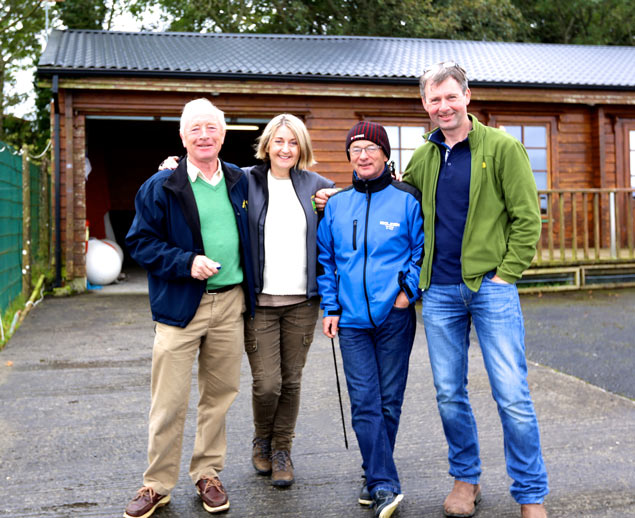 Mullingar SC people who made the recent successful events on Lough Owel possible include (left to right) Pat McArdle, Veronica Lucey (PRO), Brian Walker (Hon. Treas), and MSC Commodore James Hackett
Mullingar SC people who made the recent successful events on Lough Owel possible include (left to right) Pat McArdle, Veronica Lucey (PRO), Brian Walker (Hon. Treas), and MSC Commodore James Hackett
They keep themselves below the radar in Mullingar Sailing Club, so much so that all the photos of the two big weekends there have had an absence of the hosts. They were probably too busy keeping the show on the road to pose for cameras. But Afloat.ie have managed to rustle up a couple of images with some of the key players, which we reproduce here with pleasure - and with the Irish sailing community’s heartfelt thanks to Mullingar SC and the Irish GP 14 Association for so successfully embodying the spirit of the voluntarism and generosity which is at the heart of our sport.
 All in-club catering at Mullingar was also provided by volunteers – Rosie Hackett and Susan Collender cheerfully at work
All in-club catering at Mullingar was also provided by volunteers – Rosie Hackett and Susan Collender cheerfully at work


























